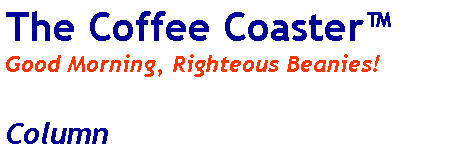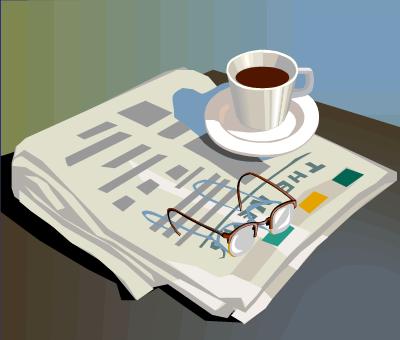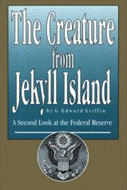

|
 |
|
He Who Has the Gold...
|
|||
Please go to the new Coffee Coaster site implemented more gracefully in Wordpress. Full conversion by 9/12. This page: http://brianrwright.com/CoffeeCoasterBlog/?p=2291 |
 It's the old joke or phrase, I believe it was from the comic strip Pogo—but it may have been The Wizard of Id or Shoe (reader input welcome). One of the characters says in conversation about politics, "Just remember the Golden Rule." "What do you mean?" "He who has the gold makes the rules." This is so entirely apt when one discusses the central banking and money machinery of the United States: the Federal Reserve System (Fed).[1] For this week's column I'm going to paraphrase Mr. G. Edward Griffin's description, in The Creature from Jekyll Island, of how the Fed works, how it creates 'money.' Like turning lead into gold, the central bankers believe in magic... and would have us believe they're Mandrake the Magician.
It's the old joke or phrase, I believe it was from the comic strip Pogo—but it may have been The Wizard of Id or Shoe (reader input welcome). One of the characters says in conversation about politics, "Just remember the Golden Rule." "What do you mean?" "He who has the gold makes the rules." This is so entirely apt when one discusses the central banking and money machinery of the United States: the Federal Reserve System (Fed).[1] For this week's column I'm going to paraphrase Mr. G. Edward Griffin's description, in The Creature from Jekyll Island, of how the Fed works, how it creates 'money.' Like turning lead into gold, the central bankers believe in magic... and would have us believe they're Mandrake the Magician.
The federales add ink to a piece of paper, create impressive designs around the edges, and call it a bond (Treasury note). It is merely a promise to pay a specified sum at a specified interest on a specified date. These notes become the foundation for almost the entire nation's money supply. The government has created cash, but it doesn't yet look like cash. Upon acquiring the IOU, the Fed now has what is called a...
An instrument of government debt is considered an asset because it is assumed the government will keep its promise to pay by means of taxation. So the Fed has an asset that can be used to offset a liability; it creates the liability by adding ink to another piece of paper which it exchanges with the government for the Treasury note. This second piece of paper is called a...
There is no money in any account to cover this check. Anyone else knowingly writing a check without funds would go to jail. It is legal for the Fed, however, because Congress wants the money, and this is the easiest way to get it—raising taxes is politically hazardous, having the public buy all the bonds is unrealistic, and literally printing large quantities of currency is obvious and controversial. Fed purchases of Treasury notes keep the process shrouded in mystery. The result is the same as turning on the government printing presses and manufacturing fiat money (money created by the order of government with nothing of tangible value backing it) to pay government expenses. In accounting terms, the books are said to be balanced because the liability of the money is offset by the 'asset' of the Treasury note. The Fed check received by the government is then endorsed and sent back to one of the Fed banks where it now becomes a...
Once the Fed check has been deposited into the government's account, it is used to pay government expenses and, thus, is transformed into many...
These checks become the means by which the first wave of fiat money floods into the economy. Recipients now deposit them into their own bank accounts where they become...
On the one hand CBDs are liabilities to the bank because they are owed back to the depositors. But so long as they remain in the bank, they also are considered assets. Once again, the books are balanced. But the process does not stop there. Through the magic of fractional reserve banking, the deposits are made to serve an additional and more lucrative purpose. The on-hand deposits now become reclassified in the books as...
Reserves for what? Are these for paying off depositors should they want to close out their accounts? No. That's the lowly function they served when they were classified as mere assets. Now that they have been given the name 'reserves,' they become the magic wand to materialize even larger amounts of fiat money. This is where the action is: at the level of commercial banks.
Here's how it works: The banks are permitted by the Fed to hold as little as 10% of their deposits in 'reserve.' That means, if they receive deposits of $1 million from the first wave of fiat money created by the Fed, they have $900,000 more than they are required to keep on hand ($1 million less 10% reserve). In bankers' language, that $900,000 is called...
The word 'excess' is a tipoff that these so-called reserves have a special destiny. Now that they have been transmuted into an excess, they are considered available for lending. And so in due course these excess reserves are converted into...
Wait a minute. How can this money be lent out when it is owned by the original depositors who are still free to write checks and spend it any time they wish? Isn't that a double claim against the same money? The answer is: when the new loans are made, they are made with brand new money generated by the Fed for that purpose (out of 'thin air'). The nation's money supply simply increases by ninety percent of the bank's deposits. Further, this new money is far more interesting to the banks than the old. The old money, which they received from depositors, requires them to pay out interest or perform services for the privilege of using it. But with the new money, the banks collect interest, instead, which is not too bad considering it cost them nothing to to make. Nor is that the end of the process. When this second wave of fiat money moves into the economy, it comes right back into the banking system, just as the first wave did, in the form of...
The process now repeats. What was a 'loan' on Friday comes back into the bank as a 'deposit' on Monday. The deposit is then reclassified as a 'reserve' and ninety percent of that becomes an 'excess' reserve that, once again, is available for a new 'loan.' Thus the $1 million of the first wave of fiat money gives birth to $900,000 in the second wave, and that gives birth to $810,000 in the third wave ($900,000 less 10% reserve). It takes about twenty-eight times through the revolving door of deposits becoming loans becoming deposits becoming more loans until the process plays itself out to the maximum effect, which is...
The amount of fiat money created by the banking cartel is approximately nine times the amount of the original government debt which made the entire process possible. When the original debt itself is added to that figure we finally have...
The total amount of fiat money created by the Fed and the commercial banks together is approximately ten times the amount of the underlying government debt. To the degree that this newly created money floods into the economy in excess of goods and services it causes the purchasing power of all money, both old and new, to decline. Prices go up because the relative value of the money has gone down. The result is the same as if that purchasing power had been taken from us in taxes.
Therefore, without realizing it, Americans have paid, on top of fed taxes, a completely hidden tax equal to many times the national debt....
Please refer to G. Edward Griffin's book, pages 195-202 for the entire discussion. Most important is #5: those who receive the government expenditures first realize the existing lower price levels before the currency is expanded throughout the economy. Meaning those closest to the government are as the prime beneficiaries of a counterfeiting operation.
[1] We American libertarians are always picking on the US Fed, but all the Western nations (G10 or G20, whatever it's up to) have central banks and compulsory money systems. The question naturally emerges, from whom do the national central banks borrow? This loaner is "The One," el supremo cartelo, who 'owns the most gold' and makes the fundamental rules. [Hint: examine the Bank for International Settlements and its allied globalist organizations.]
###
2011 August 29
Copyright © Brian Wright | The Coffee Coaster™
G. Edward Griffin | Creature from Jekyll Island | Federal Reserve | Gold
| Publish Fee: $25 Donation |  |
|||
| |
|
Main | Columns | Movie Reviews | Book Reviews | Articles | Guest |